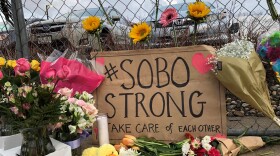In the Japanese tradition of senbazuru, it is said that if you fold 1,000 origami cranes, your wish will be granted. The idea found its way around the world with the story of Sadako Sasaki, a young girl who inspired others with her endeavor to fold enough cranes to cure her cancer, after the atomic bombing of Hiroshima.
Since then, the paper crane has become an international symbol of healing, hope and peace. Last week, local artists came to the Museum of Boulder to help with a similar effort ŌĆö the .
ŌĆ£Whenever I drive around town I always think ŌĆśI miss Boulder,ŌĆÖ because it just feels like Boulder isnŌĆÖt really here anymore - but weŌĆÖre all still here,ŌĆØ said Mariel Polifroni. The Boulder singer-songwriter and filmmaker volunteered to help with the exhibitionŌĆÖs installation. ŌĆ£So to be here with everyone today is a good reminder of that.ŌĆØ
She found out about the project through an ad asking for help from the local arts community.
ŌĆ£I jumped at the opportunity because I felt like it would really be a healing experience to participate in the installation,ŌĆØ Pollifroni said as she pulled wings from the cardboard backing used to transport the delicate paper cranes.

Los Angeles artist Karla Funderburk understands how Pollifroni feels. She began the crane project as a way to start her own healing process from the turmoil of the pandemic.
ŌĆ£It started very small,ŌĆØ Funderburk said. ŌĆ£I just started folding (by) myself, just to kind of process my own loss.ŌĆØ
Thinking of the pain and isolation people have been through this past year, she chose the crane as a symbol of hope and transition. Because while the paper cranes may be created alone, Funderburk says when theyŌĆÖre put together, they can unite us.
ŌĆ£The purpose is to recognize that what impacts you, impacts me,ŌĆØ she said. ŌĆ£Your loss is my loss.ŌĆØ
Funderburk, who is white, says she chose the origami crane in honor of its role in the process of memorializing someone, and also as a symbol of connectedness. The Memorial Crane Project has received support from organizations such as chapters of the Japan America Society and the Thousand Crane Club in Hiroshima.
ŌĆ£The purpose is to ŌĆö like the origami crane and the ritual of folding together ŌĆö is to create that unity and solidarity,ŌĆØ Funderburk said.
Eventually Funderburk plans to have exhibition sites in every state. So far, she has collected more than 120,000 cranes. Some made by her, others by people in the communities where the exhibition has appeared. They were sent to Boulder from 46 states and nine different countries, including Japan.
Approximately 10,000 of the cranes are on display in Boulder ŌĆö including some very special ones.

Hanging from the ceiling, the cranes form a spiral maze, leading the viewer to the center where there are 10 strands of 100-plus cranes each. At the end of each strand is a ribbon with a name: Eric Talley; Kevin Mahoney; Teri Leiker; Rikki Olds; Lynn Murray; Tralona Bartkowiak; Suzanne Fountain; Denny Stong; Jody Waters; and Neven Stanisic.
ItŌĆÖs a tribute to the victims of the . The cranes actually werenŌĆÖt a part of the original exhibition plan, says museum executive director Lori Preston.
ŌĆ£A group in south Boulder started folding paper cranes,ŌĆØ Preston said. ŌĆ£They had no idea what we were going to be doing in terms of the memorial cranes.ŌĆØ
Boulder couple Meridith and John Bacus and their daughter, Lita, came home from visiting the temporary memorial site that had formed around the store, and decided they needed to contribute. So they began making paper cranes for the victims. Soon neighbors were lending a hand, as well.
It was a similar instinct for Vanessa Martin. After the shooting, Martin, a botanical illustrator from Aurora, said she wanted to help the Boulder community that is grieving the same way her community grieved when a gunman entered a movie theater there almost nine years ago.
ŌĆ£I mean, just the pain and the tragedy,ŌĆØ Martin said. ŌĆ£So this was very near and dear to my heart because having gone through that with my community in Aurora, itŌĆÖs just sad. It still makes me tear up, so this felt really good to come and help.ŌĆØ
Born and raised in Los Angeles amid gun violence, Boulder-based artist Joseph Jimenez says he focuses his art on healing from that trauma. But on this day, he just wanted to help out another artist.
ŌĆ£Just kind of, ŌĆśNeed help? All right, IŌĆÖll be there,ŌĆÖŌĆØ Jimenez said.

But looking at the thousands of paper cranes, he said this was also an opportunity for something he hasnŌĆÖt yet been able to do this year: absorb all the loss of the last year.
ŌĆ£I donŌĆÖt think IŌĆÖve really processed it too well, yet,ŌĆØ Jimenez said. ŌĆ£(ItŌĆÖs just been like) on the go, next foot forward and not thinking too much about whatŌĆÖs behind. I know thereŌĆÖs a lot of people who ŌĆö I see it in their faces, I see the pain, the confusion, just trying to process it. I also see the faces of people who maybe donŌĆÖt have the time and space to process it and so theyŌĆÖre just kind of raw.ŌĆØ
For the museum, the connections made at every stage of the project are an important part of the process, Preston said.
ŌĆ£ItŌĆÖs been a long year of ŌĆö artists especially ŌĆö not being able to be among people to be able to express themselves,ŌĆØ she said. ŌĆ£And so just making the call out to them to say, ŌĆśDo you want to come and be a part of this installation?ŌĆÖ They jumped all over it.ŌĆØ
The Memorial Crane Project will be on display at the through Sept. 17, 2021.








